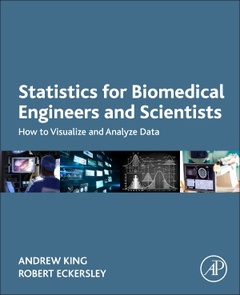Statistics for Biomedical Engineers and Scientists How to Visualize and Analyze Data
Auteurs : King Andrew P., Eckersley Robert

Statistics for Biomedical Engineers and Scientists: How to Analyze and Visualize Data provides an intuitive understanding of the concepts of basic statistics, with a focus on solving biomedical problems. Readers will learn how to understand the fundamental concepts of descriptive and inferential statistics, analyze data and choose an appropriate hypothesis test to answer a given question, compute numerical statistical measures and perform hypothesis tests ?by hand?, and visualize data and perform statistical analysis using MATLAB. Practical activities and exercises are provided, making this an ideal resource for students in biomedical engineering and the biomedical sciences who are in a course on basic statistics.
1. Descriptive Statistics I: Univariate Statistics 2. Descriptive Statistics II: Bivariate Statistics 3. Descriptive Statistics III: ROC Analysis 4. Inferential Statistics I: Basic Concepts 5. Inferential Statistics II: Parametric Hypothesis Testing 6. Inferential Statistics III: Nonparametric Hypothesis Testing 7. Inferential Statistics IV: Choosing a Hypothesis Test 8. Inferential Statistics V: Multiple Hypothesis Testing 9. Experimental Design and Sample Size Calculations 10. Statistical Shape Models 11. Case Study on Descriptive and Inferential Statistics
Biomedical; Engineers, biomedical sciences; Students, researchers
Dr. Robert Eckersley is a Senior Lecturer in the School of Biomedical Engineering and Imaging Sciences at King’s College London. His research interests include all aspects of the physics and engineering of medical ultrasound imaging. He has a long standing interest in the development of microbubble contrast agents for quantitative functional imaging with ultrasound. He is currently PI on an EPSRC grant investigating the development of super-resolution strategies for ultrasound imaging and is an co-investigator on the Wellcome and EPSRC funded iFind project http://www.ifindproject.com.
- Presents a practical guide on how to visualize and analyze statistical data
- Provides numerous practical examples and exercises to illustrate the power of statistics in biomedical engineering applications
- Gives an intuitive understanding of statistical tests
- Covers practical skills by showing how to perform operations ‘by hand’ and by using MATLAB as a computational tool
- Includes an online resource with downloadable materials for students and teachers
Date de parution : 05-2019
Ouvrage de 274 p.
19x23.3 cm
Thèmes de Statistics for Biomedical Engineers and Scientists :
Mots-clés :
2D histogram; binomial distribution; bivariate; Bland–Altman plot; box plot; categorical; chi square test; chi-square test; continuous; correlation; covariance; descriptive; discrete; dotplot; errorbar; false negative; false positive; histogram; hypothesis testing; independence; interquartile range; line graph; Mann–Whitney U test; MATLAB; mean; median; mode; multivariate joint contingency table; negative predictive value; nonparametric; Pearson's correlation coefficient; positive predictive value; probability plot correlation coefficient; quantile–quantile plot; ranked; regression; ROC analysis; scatter plot; sensitivity; Shapiro–Wilk test; sign test; skew; Spearman's correlation coefficient; specificity; standard deviation; statistics; true negative; true positive; univariate; variance; Wilcoxon signed rank test; Youden index; z-value



